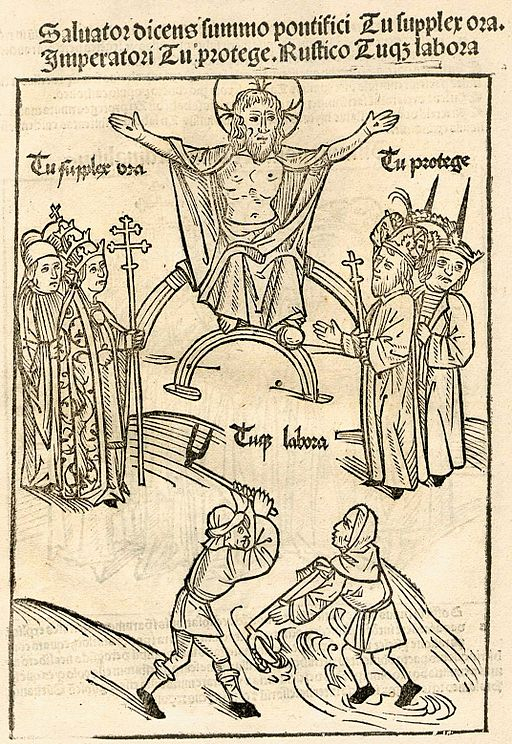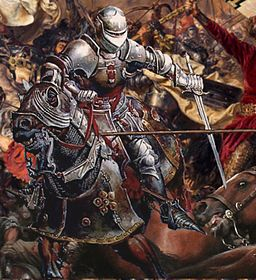

Christianity was the official religion of Romans, and with the fall of the Roman empire, it spread across Europe. Christianity was adopted by big landowners and feudal lords. Gradually Christianity started to dominate day-to-day life in Europe. The feudal lords were Christian and they started measures to popularise it. Pagans were deprived of state facilities and even punished for not being Christian. The Church became the most powerful Institution and became the biggest landowner.
The church with the monarchy became the Piller of the feudal society in Europe throughout the medieval age. This period is sometimes referred to as the Dark Ages. the links between the Kings and churches became strong. In 800 AD in France, the Pope gave the title of “Holy Roman Emperor” to king Charlemagne and gained his support. The same arrangement was between the church in Constantinople and the kingdom of Byzantine.
With the church becoming the most dominant institution, the Idea of three sections of society was given by French priests.
This idea of positioning people in certain sections became the founding stone of the three estates or orders in medieval European society. Society was divided into three sections. First, was the Clergy, second, was the nobles and last was the peasantry.

The first and the most dominating order of medieval Europe was the clergy. They were the ones who prayed and maintained the spiritual life of society. These orders consisted, The Priests, Popes, Bishops and Cardinals and all other religious individuals who worked for the Church. They were at the top of the social hierarchy.
The church had its laws, lands and power to impose taxes on peasants.
The pope was the head of the Church.
Christens in Europe were guided by the clergy class.
Women and men with physical deformities could not become priests.
The priests led a monogamous life.
Bishops had large estates at their disposal and they used to live in grand palaces and enjoy a lavish lifestyle.
This class not only oversaw the religious sphere of society but also influenced the cultural and social customs in feudal society.
The church taxed the peasants one-tenth of their produce, it was an informal tax called the ‘tithe’.
Apart from the Church, Christians in the Mediaeval age had another organisation of devout Christians who were known as Monks.
Monks were devoted Christians who lived their life in solitary. They were not members of the Church. They were different from clerics who lived among people and enjoyed a lavish lifestyle, monks lived an austere life. They lived in a community called monasteries or abbeys. Monks took the vow to live in the abbeys for their whole life praying and farming. The abbeys were general far from any human habitation. Unlike the church, it was open to all, men and women. Monks were not allowed to marry.
They helped in the spread of arts and their description is found in various pieces of literature in the late 13th and 14th centuries.
The church tried to bring the social environment and living conditions to be conditioned in the Christian way of life. For that purpose,
Churches started celebrating the birth of Christ and the date of his resurrection.
Replaced pagan Holy days with new Christian Holy days. On Holy day peasants didn't have to work and they would celebrate it.
People started going to pilgrimage to the shrines of martyrs or big Churches.
The tradition of Baptism of the newly born child became standard.
The tradition of Holy days, where people were given days off to pray, later become holidays when people enjoyed and did not work.
Nobles were the second order, after the priests. They held a high position in the administration. Nobility was generally associated with the warrior class. The nobility were free individuals with property rights and they enjoyed certain privileges.
The only obligation they had was to support their lord with the military and they has to fight for their lord. In exchange for this, they were given land and rewards.
They act as a vassal of the king, which means they had to work for their lord.
They were lords of their region, and rule under the name of the kong.
The nobility had their court for justice and the peasant acted as their vassal.
Nobility has their armies called the “feudal levies”
Big land owners had their manor-house, and they were called the manorial estates.
The manorial estates ruled villages and had their lands and peasants worked there.
They lived a lavish lifestyle and had everything they needed.
Big estates had residences for knights’ families.
Knights were another class of nobles, who were given the title and land by the king.
Knights were skilled warriors who had vowed to fight to fight for their lord when commanded.

Peasants were the third and the lowest order in society. They were manual labourers and farmers. The men had to fight as foot soldiers when the king needed them. Women and children of peasants had also to work for lords.
There were two kings of peasants, one was the Free Peasants and another was the Unfree Peasants of Serfs.
Free peasants - They had their land and they work as the tenants of the lord. The men had to work in military service, at least forty days a year and women and children had to work in the household of lords for a certain time. Peasants' families had to work certain days a week in the lord’s estate and the output directly went to the lord.
They were also required to do voluntary services, like digging the well, repairing buildings and roads etc.
Serfs or Unfree peasants - Serfs cultivated the lord’s land and they were not given any wages. Serfs were not allowed to leave the estates and they were fully controlled by the lords. Surfs had to take permission from their lord to marry.
In the medieval period, European society was classified into three orders or classes, based on their work and socio-economical status. The first and most dominating order was the Clergy and second most powerful order was the nobility and the third and the lowest order was the peasant.
The clergy were the priest and associated with religious activities. The nobility was the warrior class and they were lords and kings. They were the biggest land owners. The peasants comprised the biggest population of society and they were farmers and labourers who worked for the lords.
Q1. What was the major difference between clergy and monks?
Ans. Clergy and monks both were associated with religious practices, but the clergies lived a lavish lifestyle whereas monks lived solitary and very moderated life.
Q2. How did Christianity popularised in Europe.
Ans. After the fall of Rome, Christianity spread all across Europe and initially big land owners and lords were Christianised gradually with the help of the Church common people were made Christians.
Q3. Why did Christians celebrate Easter?
Ans. Easter was celebrated on the day when Christ was crucified and came back to life. It was celebrated to replace the old pagan Holy day.
Q4. Who gave the idea of social orders in society?
Ans. French Bishop ‘Adalbero of Laon’ claimed that, in society, some prey, some fight and still some work. From there the idea of three social orders came into origin.
Q5. What kind of work were assigned to the families of peasants?
Ans. women and children were assigned the work of spinning, weaving clothes, making candles and preparing wine for lords.